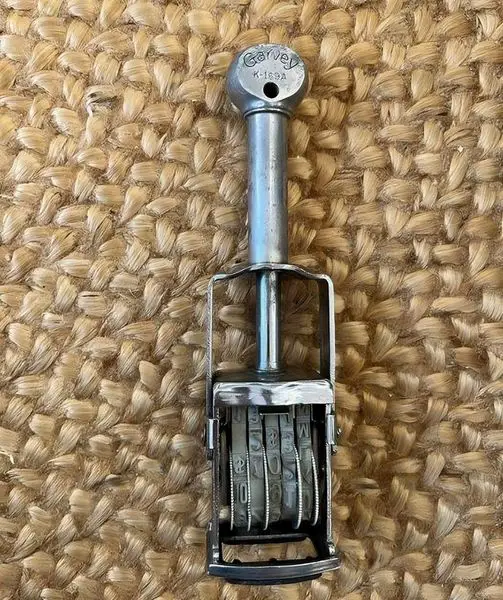In the early-to-mid 20th century, retailers faced the challenge of marking prices efficiently on a wide variety of products. Enter the vintage price marker ink stamp—a compact, manually operated tool that offered an innovative solution for its time. These stamps typically consisted of adjustable dials or rollers, allowing users to set specific prices. They required ink pads and manual stamping motions, making them both simple and functional.

Unlike today’s seamless barcode systems, these devices were labor-intensive but incredibly effective for the period. They allowed shopkeepers to ensure consistent, legible pricing, helping to create an organized shopping experience.
The Workings of Vintage Price Markers
A vintage price marker was a mechanical marvel for its era. It featured a metal or plastic casing, inside which a series of rotating bands displayed numbers, currency symbols, or custom text. Retailers could adjust these bands to set the desired price, press the device onto an ink pad, and then stamp it onto a tag or product packaging.
Key features of vintage price markers included:
- Customizable Pricing: Adjustable bands made it easy to change prices without requiring new equipment.
- Durability: Built with sturdy materials like metal, these markers could withstand heavy use in bustling shops.
- Efficiency: Despite being manual, they sped up the process of pricing large inventories compared to hand-written labels.
The Rise of Self-Inking Models
As demand for greater efficiency grew, self-inking price markers emerged as a significant upgrade. These models included built-in ink pads, eliminating the need to press the device onto an external pad. Self-inking markers were cleaner, faster, and even more user-friendly, making them a hit in the retail industry.
This advancement marked the beginning of a trend—developing tools that streamlined operations for busy shopkeepers. Yet, as with many innovations, new technology soon replaced manual devices.
The Decline of Ink Stamps: Enter the Digital Age
By the late 20th century, electronic labeling systems and barcode scanners started replacing manual pricing tools. These technologies brought unprecedented accuracy, speed, and integration into inventory systems. Retailers no longer needed to stamp individual products, as digital price tags and point-of-sale systems could handle everything seamlessly.
However, the transition wasn’t just about convenience. It was also driven by:
- Mass Production: Larger inventories demanded faster, automated pricing systems.
- Customer Expectations: Shoppers sought clarity and consistency in pricing, which digital displays delivered.
- Globalization: As stores expanded globally, standardized systems became essential.
Despite these advancements, vintage price markers retained their charm and became sought-after collectibles. For many, they symbolize a bygone era of hands-on craftsmanship and simpler times in retail.
Why Vintage Price Markers Remain Popular
Even though technology has rendered them obsolete for practical use, vintage price markers hold a special place in the hearts of collectors, hobbyists, and even historians. Their appeal lies in their nostalgic value and their role as a tangible reminder of early retail ingenuity.
Collectors are particularly drawn to:
- Unique Designs: The aesthetic appeal of vintage markers, with their intricate mechanical details and polished casings, makes them a joy to display.
- Historical Significance: These devices offer a window into the evolution of commerce and consumer culture.
- Craftsmanship: Unlike today’s mass-produced gadgets, vintage markers were built to last, showcasing exceptional attention to detail.
For those interested in owning a piece of retail history, antique shops and online marketplaces often feature these devices. Depending on their rarity and condition, they can range in price from affordable to highly collectible.
Connecting the Past to the Present
The story of vintage price markers isn’t just a tale of nostalgia—it’s a reminder of how far retail has come. From manual stamps to self-inking devices, to digital scanners and smart price tags, the journey reflects humanity’s relentless pursuit of efficiency and innovation.
Modern systems like QR codes, dynamic pricing, and AI-driven inventory management might seem worlds apart from the simplicity of vintage price markers. Yet, the core idea remains the same: to make shopping an organized and enjoyable experience for both retailers and customers.
Conclusion
Vintage price markers may no longer be a staple in today’s retail landscape, but their legacy lives on. They remind us of a time when technology was tangible, tools were built to last, and innovation didn’t necessarily mean complexity.
Whether you’re a collector, a history enthusiast, or just someone who enjoys reflecting on the past, these devices hold an undeniable charm. They serve as a bridge between eras, showing how the smallest tools can have a lasting impact on an industry.
So, the next time you see a sleek barcode scanner or a digital price tag, take a moment to appreciate the journey that brought us here—starting with something as humble as a vintage price marker ink stamp.

